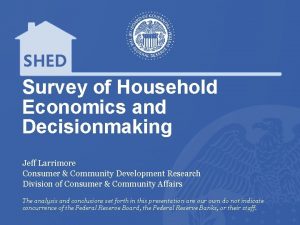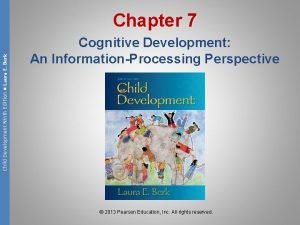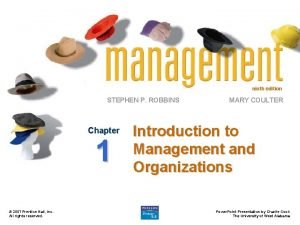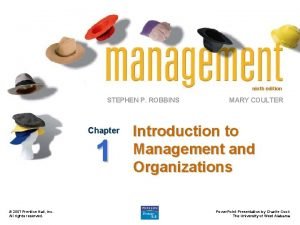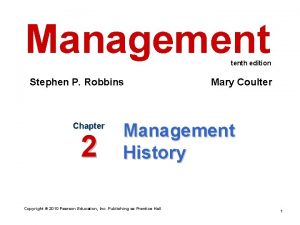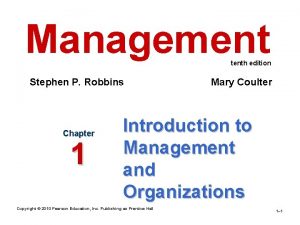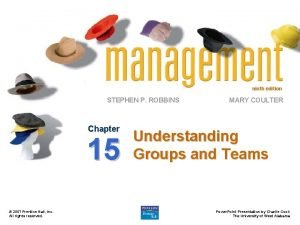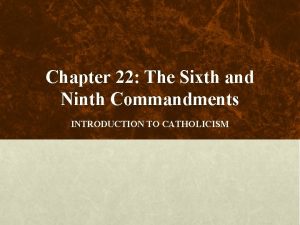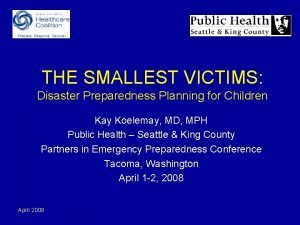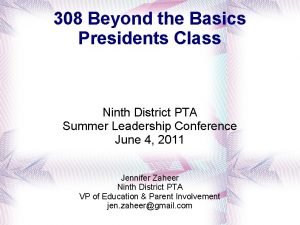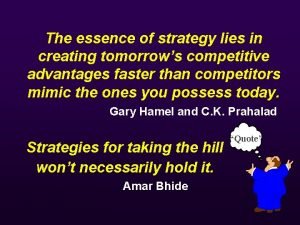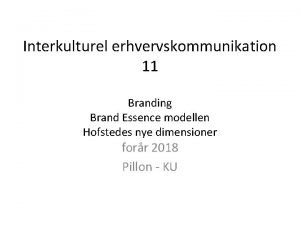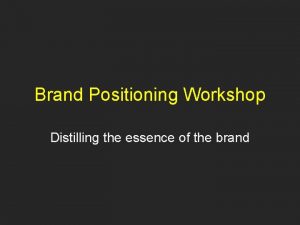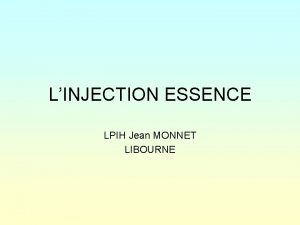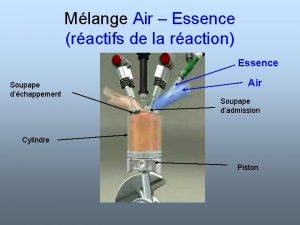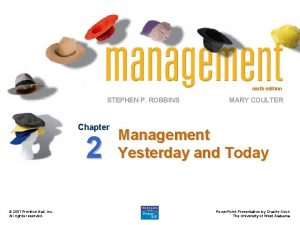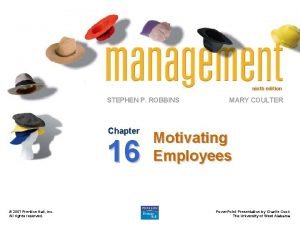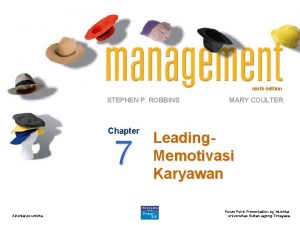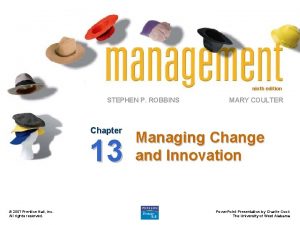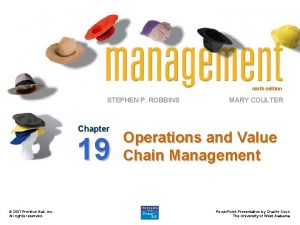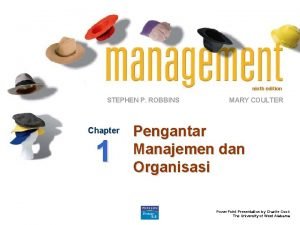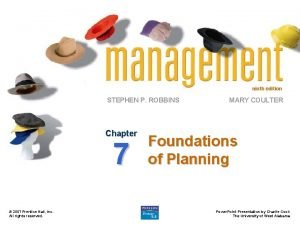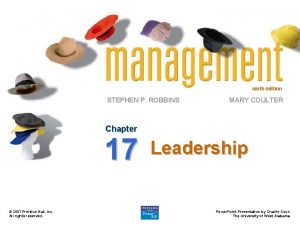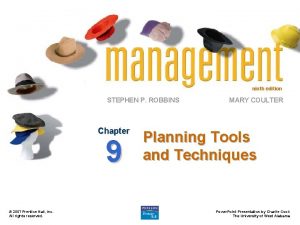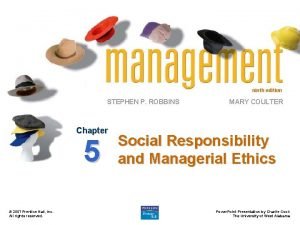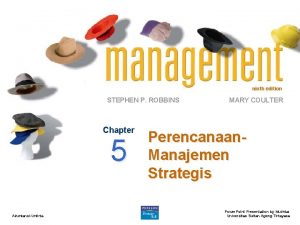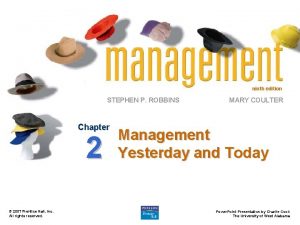Chapter ninth edition 6 DecisionMaking The Essence STEPHEN









































- Slides: 41

Chapter ninth edition 6 Decision-Making: The Essence STEPHEN P. ROBBINS MARY COULTER of the Manager’s Job Formatted by: Shahbaz Khan © 2007 Prentice Hall, Inc. All rights reserved. Power. Point Presentation by Charlie Cook The University of West Alabama

L E A R N I N G O U T L I N E Follow this Learning Outline as you read and study this chapter. The Decision-Making Process • Define decision and decision-making process. • Describe the eight steps in the decision-making process. The Manager as Decision Maker • Discuss the assumptions of rational decision making. • Describe the concepts of bounded rationality, satisficing, and escalation of commitment. • Explain intuitive decision making. • Contrast programmed and nonprogrammed decisions. © 2007 Prentice Hall, Inc. All rights reserved. 6– 2

L E A R N I N G O U T L I N E (cont’d) Follow this Learning Outline as you read and study this chapter. The Manager as Decision Maker (cont’d) • Contrast the three decision-making conditions. • Explain maximax, maximin, and minimax decision choice approaches. • Describe the four decision making styles. • Discuss the twelve decision-making biases managers may exhibit. • Describe how manager can deal with the negative effects of decision errors and biases. • Explain the managerial decision-making model. © 2007 Prentice Hall, Inc. All rights reserved. 6– 3

L E A R N I N G O U T L I N E (cont’d) Follow this Learning Outline as you read and study this chapter. Decision Making for Today’s World • Explain how managers can make effective decisions in today’s world. • List six characteristics of an effective decision-making process. • Describe the five habits of highly reliable organizations. © 2007 Prentice Hall, Inc. All rights reserved. 6– 4

Decision Making • Decision Ø Making a choice from two or more alternatives. • The Decision-Making Process Ø Identifying a problem and decision criteria and allocating weights to the criteria. Ø Developing, analyzing, and selecting an alternative that can resolve the problem. Ø Implementing the selected alternative. Ø Evaluating the decision’s effectiveness. © 2007 Prentice Hall, Inc. All rights reserved. 6– 5

Exhibit 6– 1 The Decision-Making Process © 2007 Prentice Hall, Inc. All rights reserved. 6– 6

Step 1: Identifying the Problem • Problem Ø A discrepancy(difference) between an existing and desired state of affairs. • Characteristics of Problems Ø A problem becomes a problem when a manager becomes aware of it. Ø There is pressure to solve the problem. Ø The manager must have the authority, information, or resources needed to solve the problem. © 2007 Prentice Hall, Inc. All rights reserved. 6– 7

Step 2: Identifying Decision Criteria • Decision criteria are factors that are important (relevant) to resolving the problem. Ø Costs that will be incurred (investments required) Ø Risks likely to be encountered (chance of failure) Ø Outcomes that are desired (growth of the firm) Step 3: Allocating Weights to the Criteria • Decision criteria are not of equal importance: Ø Assigning a weight to each item places the items in the correct priority order of their importance in the decision making process. © 2007 Prentice Hall, Inc. All rights reserved. 6– 8

Exhibit 6– 2 Criteria and Weights for Computer Replacement Decision Criterion Weight Memory and Storage 10 Battery life 8 Carrying Weight 6 Warranty 4 Display Quality 3 © 2007 Prentice Hall, Inc. All rights reserved. 6– 9

Step 4: Developing Alternatives • Identifying viable alternatives Ø Alternatives are listed (without evaluation) that can resolve the problem. Step 5: Analyzing Alternatives • Appraising each alternative’s strengths and weaknesses Ø An alternative’s appraisal is based on its ability to resolve the issues identified in steps 2 and 3. © 2007 Prentice Hall, Inc. All rights reserved. 6– 10

Exhibit 6– 3 Assessed Values of Laptop Computers Using Decision Criteria © 2007 Prentice Hall, Inc. All rights reserved. 6– 11

Step 6: Selecting an Alternative • Choosing the best alternative Ø The alternative with the highest total weight is chosen. Step 7: Implementing the Alternative • Putting the chosen alternative into action. Ø Conveying the decision to and gaining commitment from those who will carry out the decision. © 2007 Prentice Hall, Inc. All rights reserved. 6– 12

Exhibit 6– 4 Evaluation of Laptop Alternatives Against Weighted Criteria © 2007 Prentice Hall, Inc. All rights reserved. 6– 13

Step 8: Evaluating the Decision’s Effectiveness • The soundness of the decision is judged by its outcomes. Ø How effectively was the problem resolved by outcomes resulting from the chosen alternatives? Ø If the problem was not resolved, what went wrong? © 2007 Prentice Hall, Inc. All rights reserved. 6– 14

An example of MIS System • MIS software covers aspects related to admission, registration, department, faculty management, timetable, date sheet management, course coverage and attendance. It facilitates the function of accounts department along with examination department © 2007 Prentice Hall, Inc. All rights reserved. 6– 15

Making Decisions • Rationality(Samajdari) Example-Acquisition of HP and Compaq – Warid and Jazz Ø Managers make consistent, value-maximizing choices with specified constraints. Ø Managers are not always rational Ø Assumptions( Mafrooza) are that decision makers: v Are perfectly rational, fully objective, and logical. v Have carefully defined the problem and identified all viable alternatives. v Have a clear and specific goal. v Will select the alternative that maximizes outcomes in the organization’s interests rather than in their personal interests. © 2007 Prentice Hall, Inc. All rights reserved. v (Tender of Wapda by my friend-wrong pricing) 6– 16

Exhibit 6– 6 Assumptions of Rationality © 2007 Prentice Hall, Inc. All rights reserved. 6– 17

Making Decisions (cont’d) • Bounded Rationality Ø Managers make decisions rationally, but are limited (bounded) by their ability to process information. Ø Use maximum alternatives to achieve your goal. Ø Assumptions are that decision makers: v Will not seek out or have knowledge of all alternatives v Will satisfice—choose the first alternative encountered that satisfactorily solves the problem—rather than maximize the outcome of their decision by considering all alternatives and choosing the best. Two “IT” graduates in Canada one is bus driver and other is IT professional © 2007 Prentice Hall, Inc. All rights reserved. 6– 18

Exhibit 6– 5 Decisions in the Management Functions © 2007 Prentice Hall, Inc. All rights reserved. 6– 19

Making Decisions (cont’d) • Influence on decision making • Escalation of commitment: An increased commitment to a previous decision despite evidence that it may have been wrong. Disaster of Space Shuttle “Challenger” Tony Blair says” SOORY” over Iraq War” after 12 years © 2007 Prentice Hall, Inc. All rights reserved. 6– 20

The Role of Intuition • Intuitive (capable of knowing without reasoning) decision making Ø Making decisions on the basis of experience, feelings, and accumulated judgment. Half of executive surveyed” used intuition more than formal analysis to run their companies” Yesterdays meeting with Dir OSA about foreign tours © 2007 Prentice Hall, Inc. All rights reserved. 6– 21

Exhibit 6– 7 What is Intuition? Source: Based on L. A. Burke and M. K. Miller, “Taking the Mystery Out of Intuitive Decision Making, ” Academy of Management Executive, October 1999, pp. 91– 99. © 2007 Prentice Hall, Inc. All rights reserved. 6– 22

Types of Problems and Decisions • Structured Problems Ø Involve goals that clear. Ø Are familiar (have occurred before). Ø Are easily and completely defined—information about the problem is available and complete. Ø Class make up Ø Purchase returning to a store Ø News team response to a sudden breaking news • Programmed Decision Ø A repetitive decision that can be handled by a routine approach. © 2007 Prentice Hall, Inc. All rights reserved. 6– 23

Types of Programmed Decisions • Policy Ø A general guideline for making a decision about a structured problem. • Procedure Ø A series of interrelated steps that a manager can use to respond (applying a policy) to a structured problem. Show sales receipt • Rule Ø An explicit statement that limits what a manager or employee can or cannot do(only store manager can refund) © 2007 Prentice Hall, Inc. All rights reserved. 6– 24

Policy, Procedure, and Rule Examples • Policy Ø Accept all customer-returned merchandise. • Procedure Ø Follow all steps for completing merchandise return documentation. • Rules Ø Managers must approve all refunds over $50. 00. Ø No credit purchases are refunded for cash. © 2007 Prentice Hall, Inc. All rights reserved. 6– 25

Problems and Decisions (cont’d) • Unstructured Problems Ø Problems that are new or unusual and for which information is ambiguous or incomplete. Ø Problems that will require custom-made solutions. Ø One passport was delivered late for Malaysian tour Ø Mishandling of a customer by Budget car Rental Company ” Wedding Car” • Non programmed Decisions Ø Decisions that are unique and nonrecurring. Ø Decisions that generate unique responses. © 2007 Prentice Hall, Inc. All rights reserved. 6– 26

Exhibit 6– 8 Programmed versus Nonprogrammed Decisions © 2007 Prentice Hall, Inc. All rights reserved. 6– 27

Decision-Making Conditions • While making decisions, Managers may face three different conditions: Certainty, Risk and uncertainty • Certainty Ø A situation in which a manager can make an accurate decision because the outcome of every alternative choice is known. (while exchanging $, Riyal you always know the rate. • Risk Ø A situation in which the manager is able to estimate the likelihood (probability) of outcomes that result from the choice of particular alternatives. New room in a hotel in Murree. © 2007 Prentice Hall, Inc. All rights reserved. 6– 28

Decision-Making Conditions • Uncertainty Ø Limited information prevents estimation of outcome probabilities for alternatives associated with the problem and may force managers to rely on intuition and “gut feelings”. v Maximax: the optimistic manager’s choice to maximize the maximum payoff(Advantages) v Maximin: the pessimistic(worst will happen) manager’s choice to maximize the minimum payoff. (Largest of minimum payoff) v Minimax: the manager’s choice to minimize maximum regret. Regret (opportunity loss through having made the wrong decision) © 2007 Prentice Hall, Inc. All rights reserved. 6– 29

Exhibit 6– 10 Payoff (Advantages) Matrix © 2007 Prentice Hall, Inc. All rights reserved. 6– 30

Exhibit 6– 11 Regret Matrix © 2007 Prentice Hall, Inc. All rights reserved. 6– 31

Decision-Making Styles • Dimensions (boundaries)of Decision-Making Styles Ø Ways of thinking v (Source of information), v (How you process information) Ø Tolerance for ambiguity(Shak) v Low tolerance: require consistency and order v High tolerance: multiple thoughts simultaneously © 2007 Prentice Hall, Inc. All rights reserved. 6– 32

Decision-Making Styles (cont’d) • Types of Decision Makers Ø Directive(Autocratic style) v Use minimal information and consider few alternatives. Ø Analytic(Data based- very detail oriented) v Make careful decisions in unique situations. Ø Conceptual (Long term thinker-Visionary person) v Maintain a broad outlook and consider many alternatives in making decisions. Ø Behavioral ( Take other’s opinion) v Avoid conflict by working well with others and being receptive to suggestions. © 2007 Prentice Hall, Inc. All rights reserved. 6– 33

Exhibit 6– 13 Common Decision-Making Errors and Biases © 2007 Prentice Hall, Inc. All rights reserved. 6– 34

Decision-Making Biases and Errors • Heuristics Ø Using “rules of thumb”( A rule, or guideline, based on experience and sound judgement rather than scientific knowledge) Overconfidence Bias(Favoritism) Ø Holding unrealistically positive views of one’s self and one’s performance. (we will win the tender, Victory of cricket team) • Immediate Gratification(Satisfaction) Bias Ø Choosing alternatives that offer immediate rewards and that to avoid immediate costs. (New employee producing from the day 1) © 2007 Prentice Hall, Inc. All rights reserved. 6– 35

Decision-Making Biases and Errors (cont’d) • Anchoring (Hallo)Effect Ø Human tendency to rely too heavily, or "anchor, " on one trait or piece of information when making decisions. . example, a person looking to buy a used car - they may focus excessively on the odometer reading and the year of the car, and use those criteria as a basis for evaluating the value of the car, rather than considering how well the engine or the transmission is maintained. • Selective Perception Bias Ø Selecting organizing and interpreting events based on the decision maker’s biased perceptions. (measure employee satisfaction but only ask employees from one department) • Confirmation Bias Ø looking for information to justify the decision you are already planning to make. (job interview- employer already decided to hire some one) © 2007 Prentice Hall, Inc. All rights reserved. 6– 36

Decision-Making Biases and Errors (cont’d) • Framing Bias Ø Selecting and highlighting certain aspects of a situation while ignoring other aspects. People tend to avoid risk when a negative frame is presented but seek risks when a positive frame is presented. ( flat 50% sale) • Availability Bias Ø Losing decision-making objectivity by focusing on the most recent events. lottery organizers heavily promote the jackpot winners, people are continually hearing about those who’ve won big), Prize bond etc • Representation Bias Ø Drawing analogies(comparison) and seeing identical situations when none exist. if someone was to describe an older woman as warm and caring with a great love of children, most of us would assume that the older woman is a grandmother • Randomness Bias Ø Creating unfounded meaning out of random events. © 2007 Prentice Hall, Inc. All rights reserved. 6– 37

Decision-Making Biases and Errors (cont’d) • Sunk Costs Errors • It’s something that you already spent and that you won’t get back, regardless of future outcomes. (It’s like that gym club membership you bought: whether you get its benefits or not, the money is gone and there’s no way to get it back) • Self-Serving Bias Ø Taking quick credit for successes and blaming outside factors for failures. ( I am intelligent) • Hindsight Bias Ø Mistakenly believing that an event could have been predicted once the actual outcome is known (after-the-fact). (I knew it). A letter comes in the mail informing an individual that he was accepted into a college. When he tells his mother she says, “I really had a feeling that you were going to get in” (even though she had expressed doubts to his father earlier that week). © 2007 Prentice Hall, Inc. All rights reserved. 6– 38

Exhibit 6– 14 Overview of Managerial Decision Making © 2007 Prentice Hall, Inc. All rights reserved. 6– 39

Decision Making for Today’s World • Guidelines for making effective decisions: Ø Understand cultural differences. Ø Know when it’s time to call it quits. (if decision is not viable. Kalabagh Dam) Ø Use an effective decision-making process. • Habits of highly reliable organizations (HROs) Ø Are not tricked(cheated) by their success. Ø Defer to the experts on the front line. Ø Let unexpected circumstances provide the solution. Ø Embrace complexity. Ø Anticipate, but also anticipate their limits. © 2007 Prentice Hall, Inc. All rights reserved. 6– 40

Terms to Know • • • • decision-making process problem decision criteria rational decision making bounded rationality satisficing escalation of commitment intuitive decision making structured problems programmed decision procedure rule © 2007 Prentice Hall, Inc. All rights reserved. • • • policy unstructured problems nonprogrammed decisions certainty risk uncertainty directive style analytic style conceptual style behavioral style heuristics business performance management (BPM) software 6– 41
 Survey of household economics and decisionmaking
Survey of household economics and decisionmaking Levels of analysis psychology
Levels of analysis psychology Mankiw macroeconomics 9th edition
Mankiw macroeconomics 9th edition Anatomy and physiology ninth edition
Anatomy and physiology ninth edition General adaptation syndrome
General adaptation syndrome Social psychology ninth edition
Social psychology ninth edition Biology ninth edition
Biology ninth edition Laura e berk child development (9th edition pdf)
Laura e berk child development (9th edition pdf) Child development 9th edition
Child development 9th edition Lysanx
Lysanx Psychology ninth edition in modules
Psychology ninth edition in modules Psychology ninth edition david g myers
Psychology ninth edition david g myers Biology ninth edition
Biology ninth edition Campbell ninth edition
Campbell ninth edition Meaning of initmacy
Meaning of initmacy Robbins 2007
Robbins 2007 Management by stephen p robbins 9th edition
Management by stephen p robbins 9th edition Management stephen robbins 10th edition
Management stephen robbins 10th edition Management by stephen p robbins 10th edition download
Management by stephen p robbins 10th edition download Management stephen robbins notes
Management stephen robbins notes Management stephen p robbins 11th edition
Management stephen p robbins 11th edition Stephen p robbins management 15th edition pdf
Stephen p robbins management 15th edition pdf Management eleventh edition
Management eleventh edition Management eleventh edition stephen p robbins
Management eleventh edition stephen p robbins Catholic sixth commandment
Catholic sixth commandment The sixth and ninth commandments
The sixth and ninth commandments Photo greek root
Photo greek root What's ramadan
What's ramadan William blount 9th grade academy
William blount 9th grade academy Lower ninth ward
Lower ninth ward French classical menu example
French classical menu example Ninth district pta
Ninth district pta Using mis 10th edition
Using mis 10th edition Chapter 1
Chapter 1 Personality is the essence of
Personality is the essence of The essence of strategy is
The essence of strategy is May the essence of christmas
May the essence of christmas Brand essence model
Brand essence model Tea & coffee extract & essence
Tea & coffee extract & essence Existence precedes essence in french
Existence precedes essence in french How coordination is the essence of management
How coordination is the essence of management Brand positioning workshop
Brand positioning workshop
